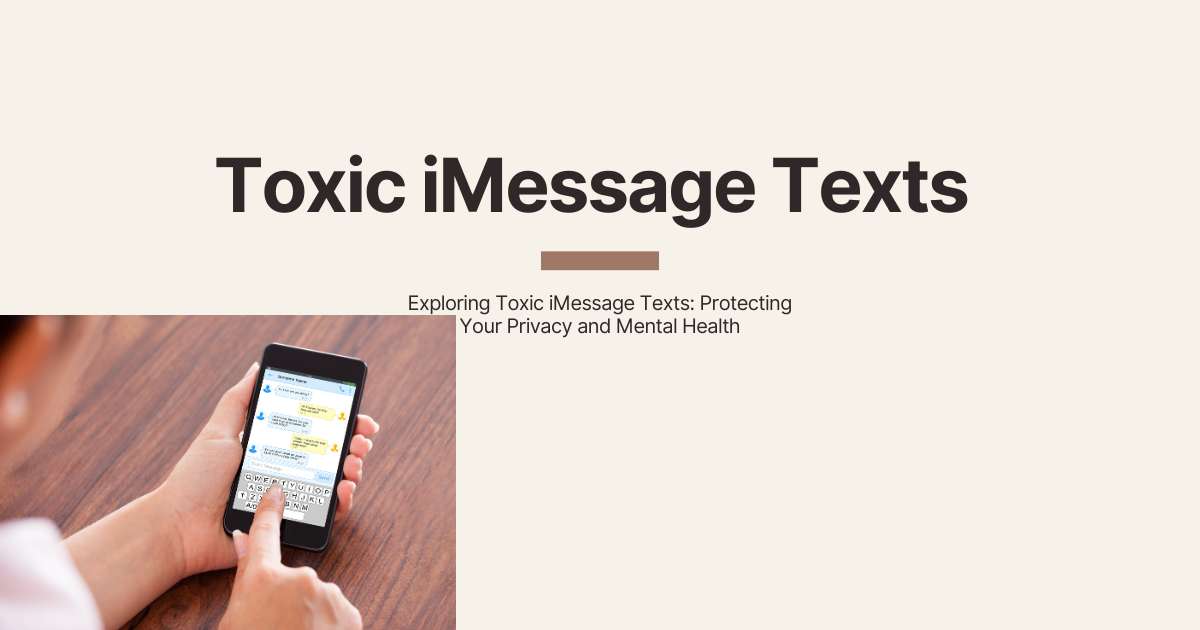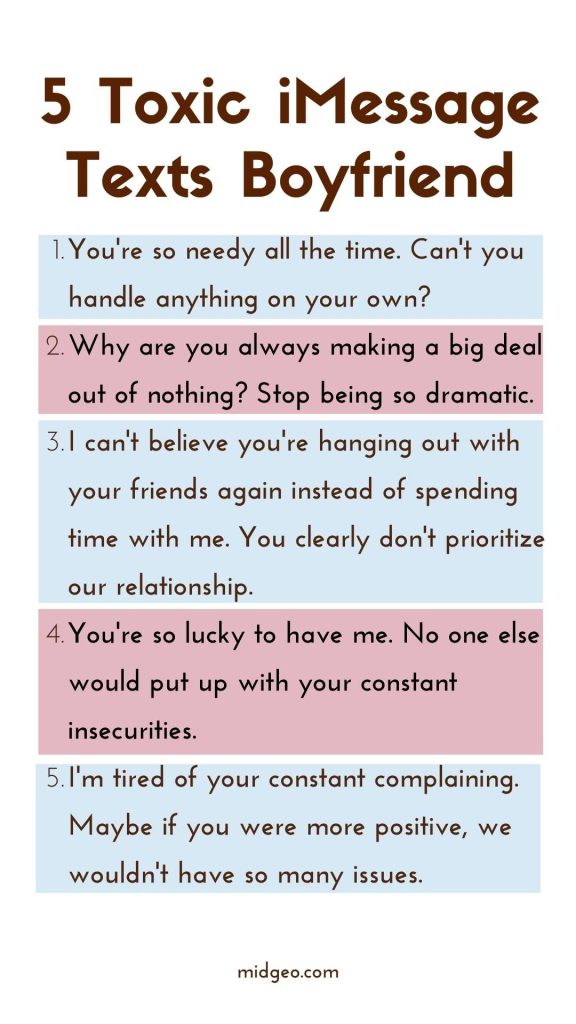Exploring Toxic iMessage Texts: Protecting Your Privacy and Mental Health

Toxic iMessage texts have become increasingly prevalent in modern relationships, often serving as a platform for harmful communication patterns.
Whether it’s passive-aggressive remarks, gaslighting, or outright manipulation, these toxic messages can significantly impact the dynamics of a relationship.
It’s crucial to recognize the significance of addressing privacy concerns and maintaining emotional well-being in the realm of digital communication.
185 Interesting Questions to Ask a Guy: Get to Know Him Better
iMessage, being a commonly used platform for intimate conversations, poses unique challenges when it comes to protecting personal boundaries and fostering healthy interactions.
Prioritizing privacy and emotional health is essential for nurturing fulfilling and respectful relationships in today’s digital age.
Understanding Toxic iMessage Texts
Content Summery
Identifying signs of toxicity in iMessage conversations is crucial for recognizing when communication patterns become harmful.
These signs may include constant criticism, manipulation, passive-aggressive behavior, gaslighting, or disregard for boundaries.
Paying attention to the tone, frequency, and content of messages can help pinpoint toxic dynamics.
The impact of toxic iMessage texts on mental health and relationship dynamics can be profound. Constant exposure to negativity, manipulation, or emotional abuse through iMessage can lead to increased stress, anxiety, and feelings of inadequacy.
Moreover, it can erode trust, intimacy, and communication within the relationship, creating barriers to healthy interaction and mutual respect.
Recognizing these effects is essential for addressing toxicity and promoting emotional well-being.
Protecting Your Privacy
Implementing privacy settings on iMessage is an important step in safeguarding personal information and maintaining control over communication.
This includes adjusting settings related to read receipts, message previews, and blocking unwanted contacts.
By configuring these settings according to personal preferences, users can enhance their privacy and security on the platform.
Handling fake girlfriend or fake text message iPhone situations requires a proactive approach to address potential threats to privacy and emotional well-being.
This may involve setting boundaries with individuals who engage in deceptive behavior, confronting the issue directly with honesty and assertiveness, and seeking support from trusted friends or professionals if necessary.
Additionally, staying vigilant and cautious about sharing personal information online can help prevent future incidents of deception or manipulation.
Navigating Emotional Well-being
Setting boundaries in iMessage communication is essential for preserving mental health and fostering healthy relationships.
This involves clearly communicating personal limits, such as acceptable topics of conversation, response times, and respectful communication norms.
By asserting boundaries and enforcing them consistently, individuals can protect themselves from emotional harm and maintain a sense of autonomy in their interactions.
Seeking support and resources for dealing with toxic messages is crucial for mitigating the negative impact of harmful communication patterns.
This may include reaching out to trusted friends, family members, or mental health professionals for guidance and support.
Additionally, exploring online resources, such as articles, forums, or hotlines, can provide valuable insights and strategies for coping with toxic messages and building resilience in challenging situations.
5 Toxic iMessage Texts Boyfriend

Here are examples of toxic iMessage texts from a boyfriend:
- “You’re so needy all the time. Can’t you handle anything on your own?”
- “Why are you always making a big deal out of nothing? Stop being so dramatic.”
- “I can’t believe you’re hanging out with your friends again instead of spending time with me. You clearly don’t prioritize our relationship.”
- “You’re so lucky to have me. No one else would put up with your constant insecurities.”
- “I’m tired of your constant complaining. Maybe if you were more positive, we wouldn’t have so many issues.”
These messages exhibit elements of toxicity such as criticism, manipulation, and invalidation of feelings, which can harm the recipient’s emotional well-being and the dynamics of the relationship.
5 iMessage Texts And Meaning
Here are five iMessage texts and their potential meanings:
- “Hey, are you busy?” – This message could indicate that the sender wants to engage in conversation or make plans with the recipient.
- “I’m sorry, I made a mistake.” – This message suggests that the sender is acknowledging fault or wrongdoing and is seeking forgiveness or resolution.
- “I miss you so much.” – This message expressed longing and affection, indicating that the sender is feeling emotionally connected to the recipient and desires their presence.
- “Can we talk later?” – This message implies that the sender wants to have a conversation with the recipient but may not have the time or opportunity to do so immediately.
- “I need some space right now.” – This message communicates that the sender is feeling overwhelmed or in need of alone time, emphasizing the importance of respecting boundaries and giving them the necessary space.
5 Fake Text Message iPhone
- “Hey, it’s your crush! I’ve been thinking about you a lot lately. Want to go out sometime?”
- “Congratulations! You’ve won a free iPhone! Click this link to claim your prize.”
- “Your bank account has been compromised. Please provide your account details to resolve the issue.”
- “Your package has been delayed. Click here to track its status.”
- “Your iCloud account has been hacked. Please enter your login credentials to secure your account.”
These fake text messages are designed to deceive the recipient into taking action or revealing sensitive information, such as personal details or login credentials, which can lead to identity theft or other forms of fraud.
It’s important to be cautious and verify the authenticity of messages before responding or clicking on any links.
5 Boyfriend Text Messages I Love You
- “I love you more than words can express. You mean everything to me.”
- “Just a reminder: I love you today, tomorrow, and always. You’re my everything.”
- “No matter where life takes us, my love for you will always remain constant and true. I love you endlessly.”
- “You’re not just my boyfriend; you’re my best friend and my greatest love. I love you more than you’ll ever know.”
- “Three simple words, but they hold the entirety of my heart: I love you.”
5 Cute Sayings for Your Boyfriend Relationships Text Messages
- “Every moment with you feels like a sweet melody playing in my heart.”
- “You’re not just my love, you’re my favorite adventure.”
- “In a world full of chaos, you’re my peaceful oasis.”
- “You’re the missing piece I never knew I needed until I found you.”
- “Being with you is like having a constant ray of sunshine in my life.”
5 Pranks Ideas Boyfriend Text Messages Short
- “Hey, I accidentally dropped your phone in the toilet… Just kidding! Gotcha! 😂”
- “Babe, I think I accidentally sent a text meant for my ex… Oh wait, April Fools’! You’re the only one for me. 😜”
- “I may have accidentally ‘borrowed’ your favorite shirt without asking… Oops, just kidding! It’s safe and sound in your closet. 😅”
- “Hey, so I accidentally ordered 10 pizzas to your place… Just kidding! But now that I’ve got your attention, want to grab some pizza tonight? 🍕😄”
- “Guess what? I just accidentally booked us tickets for a romantic getaway… April Fools’! But hey, we can always plan one for real, right? 😉”
How to Edit iMessage Texts?
To edit iMessage texts on an iPhone:
- Open the Messages app on your iPhone.
- Find the conversation containing the text you want to edit.
- Tap and hold the message you wish to edit until a menu appears.
- Select “More” from the menu options.
- Tap on the message again to open the editing field.
- Make the desired changes to the text.
- Once you’ve finished editing, tap “Done” to save your changes.
- The edited message will appear with an “Edited” label below it to indicate that it has been modified.
Please note that you can only edit iMessage texts if they have not been sent as SMS or iMessage. Additionally, the ability to edit messages may vary depending on your device’s software version and settings.
Aesthetic iMessage Texts: Balancing Style and Substance
Exploring the allure of aesthetic iMessage texts involves delving into the visual appeal and creativity that these messages offer.
From unique fonts and colors to expressive emojis and GIFs, aesthetic messaging adds an artistic touch to digital communication, making conversations more engaging and enjoyable.
Maintaining authenticity and healthy communication in aesthetic messaging is essential for ensuring meaningful connections and genuine interactions.
While aesthetics enhance the visual appeal of messages, it’s important to prioritize substance by expressing sincere thoughts, feelings, and intentions.
By striking a balance between style and authenticity, aesthetic iMessage texts can elevate conversations while fostering genuine connections.
In conclusion, handling toxic iMessage texts requires proactive strategies such as setting boundaries, recognizing signs of toxicity, and seeking support when needed.
By asserting boundaries and addressing toxic behavior assertively, individuals can protect their emotional well-being and maintain healthy relationships in the digital realm.
Moving forward, it’s crucial to prioritize privacy and emotional well-being in digital communication.
By implementing privacy settings, setting boundaries, and seeking support when needed, individuals can navigate the complexities of iMessage communication while safeguarding their personal information and fostering healthy connections.
Remember, your well-being matters, both online and offline.
